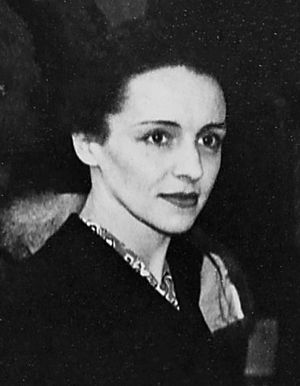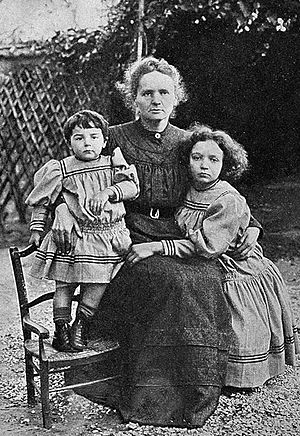Ève Curie facts for kids
Quick facts for kids
Ève Curie
|
|
|---|---|

Curie in 1937
|
|
| Born | Ève Denise Curie December 6, 1904 Paris, France |
| Died | October 22, 2007 (aged 102) New York City, U.S. |
| Occupation | Journalist, pianist |
| Citizenship | France (1904–2007) United States (1958–2007) |
| Education | BA in Science BA in Philosophy |
| Alma mater | Collège Sévigné |
| Notable works | Madame Curie (1937) Journey Among Warriors (1943) |
| Notable awards | National Book Award (1937) Croix de guerre Légion d'Honneur (2005) |
| Spouse | |
| Relatives | Marie Curie (mother) Pierre Curie (father) Irène Joliot-Curie (sister) |
Ève Denise Curie Labouisse (born December 6, 1904, died October 22, 2007) was a talented French and American writer, journalist, and pianist. She was the younger daughter of the famous scientists Marie Curie and Pierre Curie. Her older sister was Irène Joliot-Curie. Ève became known for her writing, especially her mother's biography, Madame Curie, and a book about her experiences as a war reporter, Journey Among Warriors.
From the 1960s, Ève dedicated herself to working for UNICEF. She helped children and mothers in developing countries around the world. Ève was the only one in her family who did not become a scientist or win a Nobel Prize. However, her husband, Henry Richardson Labouisse Jr., accepted the Nobel Peace Prize in 1965 on behalf of UNICEF. This made the Curie family unique, with five Nobel Prize winners in total.
Contents
Growing Up: Ève Curie's Childhood
Ève Denise Curie was born in Paris, France, on December 6, 1904. She was the younger daughter of the scientists Marie and Pierre Curie. Her older sister, Irène, was born in 1897. Ève's father, Pierre, died in an accident in 1906 when she was very young. He was run over by a horse cart.
After this sad event, Marie Curie took over her husband's teaching job at La Sorbonne. Marie's father-in-law, Dr. Eugène Curie, moved in to help care for the girls. He looked after them while Marie worked. When he passed away in 1910, Marie had to raise her daughters with the help of governesses.
Ève later said that as a child, she felt her mother didn't give her enough attention. But as she grew into her teens, their bond became much stronger. Marie was very careful about her daughters' education and helping them find their interests. Irène followed in her mother's footsteps and became a brilliant scientist. She won the Nobel Prize in Chemistry with her husband in 1935. Ève, however, was more interested in art and writing. Even as a child, she showed a special talent for music.
The family loved being active outdoors. They went on long walks and bike rides, no matter the weather. In summer, they went swimming. Marie even put gymnastics equipment in their garden in Sceaux, Hauts-de-Seine. Ève and Irène also learned how to sew, garden, and cook.
Although the girls were French citizens, and French was their first language, they knew about their Polish background. They also spoke Polish. In 1911, they visited Poland, which was then under Austrian rule. During this trip, they rode horses and hiked in the mountains.
Youth and Early Career
In 1921, Ève took her first trip across the Atlantic Ocean. She sailed with her sister and mother on the ship RMS Olympic to New York City. Marie Curie was a two-time Nobel Prize winner and the discoverer of radium and polonium. She received a huge welcome in America. Her daughters were also very popular with American high society. Ève was lively and joyful at parties. The newspapers even called her "the girl with radium eyes."
During the trip, Ève and Irène sometimes acted as their mother's "bodyguards." Marie usually focused on her research and preferred a simple life. She wasn't always comfortable with all the attention she received. While in the United States, Marie, Irène, and Ève met President Warren G. Harding in Washington, D.C. They also saw Niagara Falls and traveled by train to see the Grand Canyon. They returned to Paris in June 1921.
Ève, like her sister Irène, graduated from the Collège Sévigné, a private high school in Paris. She earned her baccalaureate degree in 1925. At the same time, she improved her piano skills. She gave her first concert in Paris in 1925. Later, she performed many times in Paris, in other parts of France, and in Belgium.
After Irène married Frédéric Joliot in 1926, Ève stayed with her mother in Paris. She took care of Marie and traveled with her throughout France, Italy, Belgium, and Switzerland. In 1932, they also joined the President of Czechoslovakia, Tomáš Garrigue Masaryk, on his trip to Spain.
Ève had a very different personality from her mother and sister. She was not interested in science. Instead, she preferred the humanities, like literature and art. Unlike her mother, Ève loved a refined lifestyle. Marie usually wore simple, black dresses. Ève, however, always cared about smart clothes, wore high heels and makeup, and loved to shine at parties.
Both Ève and Irène lovingly cared for their mother until she passed away. Marie died on July 4, 1934, from aplastic anemia. This condition was likely caused by her long exposure to radium. However, it is now thought that her long-term exposure to X-rays during World War I might have caused it. Marie had spent four years helping examine wounded patients with X-ray machines.
Writing Her Mother's Story
After Marie Curie's death, Ève decided to write a biography to honor her mother. She temporarily stepped away from social life. She moved to a small apartment in Auteuil, Yvelines. There, she collected and organized all the documents and letters Marie had left behind. In the autumn of 1935, Ève visited her family in Poland. She was looking for information about her mother's childhood and youth.
The result of her hard work was the biography Madame Curie. It was published at the same time in France, Britain, Italy, Spain, the United States, and other countries in 1937.
Madame Curie became popular right away. It was a bestseller in many countries, including the United States. In the U.S., it won the National Book Award for Non-Fiction in 1937. A film based on the book was made in 1943 by Metro-Goldwyn-Mayer, starring Greer Garson as Marie Curie.
Ève became more and more involved in writing and journalism. Besides her mother's biography, she wrote music reviews for the Candide weekly newspaper. She also wrote articles about theater, music, and film for other newspapers in Paris.
Ève Curie During World War II
When World War II started in 1939, Ève Curie took on an important role. The French Information Commissioner, Jean Giraudoux, appointed her head of the women's division in his office. When Germany invaded France, Ève left Paris on June 11, 1940. After France surrendered, she fled to England on a crowded ship, which was attacked by German planes.
In England, she joined the Free French Forces led by General Charles de Gaulle. She actively fought against Nazism. Because of this, the Vichy government in France took away her French citizenship and seized her property in 1941.
Ève Curie spent most of the war years in Britain and the United States. In the U.S., she gave lectures and wrote articles for American newspapers, mainly the New York Herald Tribune. In 1940, she met Eleanor Roosevelt at the White House. This visit inspired her to give a series of lectures called French Women and the War. In May 1940, The Atlantic Monthly magazine published her essay with the same title.
From November 1941 to April 1942, Ève Curie traveled as a war reporter. She visited Africa, the Soviet Union, and Asia. She saw the British army's attacks in Egypt and Libya in December 1941. She also witnessed the Soviet counter-attack at Moscow in January 1942. During this journey, she met important leaders like the Shah of Iran, Mohammad Reza Pahlavi, and Chiang Kai-shek, the leader of Free China. She also met Mahatma Gandhi. She often had the chance to meet Polish soldiers who were fighting with the British or organizing the Polish Army in the Soviet Union.
Curie's reports from her journey were published in American newspapers. In 1943, they were collected into a book called Journey Among Warriors. This book was nominated for the Pulitzer Prize for Correspondence in 1944. An article in The Russian Review in 1943 praised Curie's enthusiastic and kind writing style about the people she met in the Soviet Union.
After returning to Europe, Ève Curie volunteered in the women's medical corps of the Free French during the Italian Campaign. She was promoted to lieutenant in the French 1st Armored Division. In August 1944, she landed with her troops in Provence in southern France. She was awarded the Croix de guerre for her service.
After the War and Work for UNICEF
After France was freed, Ève Curie first worked as a co-editor for the daily newspaper Paris-Presse from 1944 to 1949. She was also active in politics. For example, she was in charge of women's affairs in de Gaulle's government. In 1948, she joined other important European thinkers to ask the United Nations to recognize the state of Israel.
From 1952 to 1954, she was a special advisor to Hastings Lionel Ismay, the first Secretary General of NATO. On November 19, 1954, she married the American politician and diplomat Henry Richardson Labouisse Jr.. He served as the United States Ambassador to Greece from 1962 to 1965. Ève Curie became an American citizen in 1958.
In 1965, Ève's husband left his job in the U.S. government. The UN Secretary General U Thant offered him the position of executive director of the United Nations Children's Fund, UNICEF. Labouisse held this job until 1979. Ève actively supported him and also worked for UNICEF. She was often called "the First Lady of UNICEF."
Together, they visited more than 100 countries, mostly in developing parts of the world. These countries received help from UNICEF. In 1965, Labouisse, with his wife by his side, accepted the Nobel Peace Prize, which was awarded to UNICEF.
Later Life and Legacy
After her husband's death in 1987, Ève lived in New York City. She and Henry Labouisse did not have children together. However, she had a stepdaughter, Anne Peretz (Labouisse's daughter from his first marriage). All of Anne Peretz's children considered Ève their grandmother, and their children considered her their great-grandmother.
In December 2004, Ève Curie celebrated her one-hundredth birthday. On this special occasion, the Secretary General of the United Nations, Kofi Annan, visited her in her New York apartment. She also received congratulatory letters from the Presidents of the United States, George W. Bush, and France, Jacques Chirac.
In July 2005, Ève Curie Labouisse received a promotion for her work with UNICEF. She was made an 'Officier de la Légion d'Honneur' of the Republic of France. This is the country's highest honor.
She sometimes joked about her family's many achievements. "There were five Nobel Prizes in my family," she would say, "two for my mother, one for my father, one for [my] sister and brother-in-law, and one for my husband. Only I was not successful..."
Ève Curie passed away peacefully in her sleep on October 22, 2007, at her home in Manhattan. She was 102 years old.
See also
In Spanish: Ève Curie para niños


